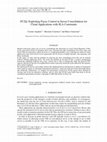articles by Marco Guazzone

Abstract We present the forensic analysis of the artifacts generated on Android smartphones by Ch... more Abstract We present the forensic analysis of the artifacts generated on Android smartphones by ChatSecure, a secure Instant Messaging application that provides strong encryption for transmitted and locally-stored data to ensure the privacy of its users. We show that ChatSecure stores local copies of both exchanged messages and files into two distinct, AES-256 encrypted databases, and we devise a technique able to decrypt them when the secret passphrase, chosen by the user as the initial step of the encryption process, is known. Furthermore, we show how this passphrase can be identified and extracted from the volatile memory of the device, where it persists for the entire execution of ChatSecure after having been entered by the user, thus allowing one to carry out decryption even if the passphrase is not revealed by the user. Finally, we discuss how to analyze and correlate the data stored in the databases used by ChatSecure to identify the \{IM\} accounts used by the user and his/her buddies to communicate, as well as to reconstruct the chronology and contents of the messages and files that have been exchanged among them. For our study we devise and use an experimental methodology, based on the use of emulated devices, that provides a very high degree of reproducibility of the results, and we validate the results it yields against those obtained from real smartphones.

Peer-to-Peer (P2P) Desktop Grids are computing infrastructures that aggregate a set of desktop-cl... more Peer-to-Peer (P2P) Desktop Grids are computing infrastructures that aggregate a set of desktop-class machines in which all the participating entities have the same roles, responsibilities, and rights. In this paper, we present ShareGrid, a P2P Desktop Grid infrastructure based on the OurGrid middleware, that federates the resources provided by a set of small research laboratories to easily share and use their computing resources. We discuss the techniques and tools we employed to ensure scalability, efficiency, and usability, and describe the various applications used on it. We also demonstrate the ability of ShareGrid of providing good performance and scalability by reporting the results of experimental evaluations carried out by running various applications with different resource requirements. Our experience with ShareGrid indicates that P2P Desktop Grids can represent an effective answer to the computing needs of small research laboratories, as long as they provide both ease of management and use, and good scalability and performance.

Modern cloud data centers rely on server consolidation (the allocation of several Virtual Machine... more Modern cloud data centers rely on server consolidation (the allocation of several Virtual Machines (VMs) on the same physical host) to minimize their costs. Choosing the right consolidation level (how many and which VMs are assigned to a physical server) is a challenging problem, since contemporary multi-tier cloud applications must meet Service Level Agreements (SLAs) in face of highly dynamic, non-stationary, and bursty workloads. In this paper, we deal with the problem of achieving the best consolidation level that can be attained without violating application SLAs. We tackle this problem by devising FC2Q, a resource management framework exploiting feedback fuzzy-logic control, that is able to dynamically adapt the physical CPU capacity allocated to the tiers of an application in order to precisely match the needs induced by the intensity of its current workload. We implement FC2Q on a real testbed, and use this implementation to demonstrate its ability of meeting the above goals by means of a thorough experimental evaluation, carried out with real-world cloud applications and workloads. Furthermore, we compare the performance achieved by FC2Q against those attained by existing state-of-the-art alternative solutions, and we show that FC2Q works better than them in all the considered experimental scenarios. . Prepared using cpeauth.cls [Version: 2010/05/13 v3.00] 2 C. ANGLANO ET AL.

Federations among sets of Cloud Providers (CPs), whereby a set of CPs agree to mutually use their... more Federations among sets of Cloud Providers (CPs), whereby a set of CPs agree to mutually use their own resources to run the VMs of other CPs, are considered a promising solution to the problem of reducing the energy cost. In this paper, we address the problem of federation formation for a set of CPs, whose solution is necessary to exploit the potential of cloud federations for the reduction of the energy bill. We devise an algorithm, based on cooperative game theory, that can be readily implemented in a distributed fashion, and that allows a set of CPs to cooperatively set up their federations in such a way that their individual profit is increased with respect to the case in which they work in isolation. We show that, by using our algorithm and the proposed CPs' utility function, they are able to self-organize into Nash-stable federations and, by means of iterated executions, to adapt themselves to environmental changes. Numerical results are presented to demonstrate the effectiveness of the proposed algorithm.

Uploads
articles by Marco Guazzone